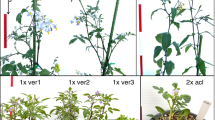Summary
Tetraploid F1 hybrids between Ipomoea batatas, sweet potato (2n = 6x = ca. 90), and diploid (2n = 2x = 30) I. trifida (H. B. K.) Don. showed various degrees of fertility reduction. The present study aimed to clarify its causes by cytological analysis of meiotic chromosome behavior in the diploid and sweet potato parents and their tetraploid hybrids. The diploid parents showed exclusively 15 bivalents, and the sweet potato parents exhibited almost perfect chromosome pairing along with predominant multivalent formation. Their hybrids (2n = 4x= 57–63) formed 2.6–5.0 quadrivalents per cell, supporting the autotetraploid nature. The meiotic aberratios of the hybrids were characterized by the formation of univalents, micronuclei, and abnormal sporads (monad, dyad, triad, and polyad). The causes underlying these aberrations were attributed in part to the multivalent formation, and in part to a disturbance in the spindle function. Three hybrids showing serious meiotic aberrations were very low in fertility. The utilization of the sweet potato-diploid I. trifida hybrids for sweet potato improvement is described and, further, the role of interploidy hybridization in the study of the sweet potato evolution is discussed.
Similar content being viewed by others
References
Austin DF (1977) Hybrid polyploids in Ipomoea section Batatas. J. Hered 68:259–260
Austin DF (1978) The Ipomoea batatas complex. I. Taxonomy. Bull Torrey Bot Club 105:114–129
Austin DF (1983) Variability in sweet potatoes. Proc Am Soc Hortic Sci Trop Region 27(B): 15–26
Austin DF (1988) The taxonomy, evolution, and genetic diversity of sweet potato and related wild species. In: Exploration, maintenance, and utilization of sweet potato genetic resources. Rep 1st Sweet Potato Planning Conf, CIP, 1987, Lima, Peru, pp 27–59
Chase SS (1963) Analytic breeding in Solanum tuberosum L.: a scheme utilizing parthenotes and other diploid stocks. Can J Genet Cytol 5:359–363
Jones A (1965) Cytological observations and fertility measurements of sweet potato (Ipomoea batatas (L.) Lam.). Proc Am Soc Hortic Sci 86:527–537
Jones A (1970) Asynapsis in Ipomoea gracilis. J Hered 61:151–152
KNAES (Kyushu National Agricultural Experiment Station) (1972–73) Crossing experiments in sweet potato. Annual Report, pp 1–124
KNAES (1981) Crossing experiments in sweet potato. Annual Report, pp 1–79
KNAES (1985) Crossing experiments in sweet potato. Annual Report, pp 1–86
Kobayashi M (1984) The Ipomoea trifida complex closely related to sweet potato. Proc 6th Symp Int Soc Trop Root Crops, CIP, 1983, Lima, Peru, pp 561–568
Kowyama Y, Shimano N, Kawase T (1980) Genetic analysis of incompatibility in the diploid Ipomoea species closely related to the sweet potato. Theor Appl Genet 58:149–155
Magoon ML, Kirshnan R, Vijaya Bai K (1970) Cytological evidence on the origin of sweet potato. Theor Appl Genet 40:360–366
Martin F, Jones A, Ruberté RM (1974) A wild Ipomoea closely related to the sweet potato. Econ Bot 28:287–292
Muramatsu M, Shiotani I (1974) Closely related wild Ipomoea species of the sweet potato in Mexico and Guatemala. In: Tanaka M (ed) A preliminary report of the Kyoto University Scientific Expedition to Latin America, 1972–1973, 1:9–30
Nishiyama I (1971) Evolution and domestication of the sweet potato. Bot Mag Tokyo 84:377–387
Nishiyama I (1982) Autohexaploid evolution of the sweet potato. In: Villareal RT, Griggs TG (eds) Sweet potato. Proc 1st Int Symp, AVRDC, 1982, Tainan, Taiwan, China, pp 263–274
Nishiyama I, Miyazaki T, Sakamoto S (1975) Evolutionary autoploidy in the sweet potato (Ipomoea batatas) and its progenitors. Euphytica 24:197–208
Sakamoto S (1976) Breeding of a new sweet potato variety, Minamiyutaka, by the use of wild relatives. Jpn Agric Res Quart 10:183–186
Shiotani I (1983) A survey of habitats of Ipomoea trifida, a closely related species to sweet potato. In: Tanaka M (ed) A preliminary report of the Kyoto University Scientific Exploration to Mexiko and Guatemala, 1981–1982, 6:9–27
Shiotani I (1988) Genomic structure and the gene flow in sweet potato and related species. In: Exploration, maintenance, and utilization of sweet potato genetic resources. Rep 1st Sweet Potato Planning Conf, CIP, 1987, Lima, Peru, pp 61–73
Shiotani I, Kawase T (1987) Synthetic hexaploids derived from wild species related to sweet potato. Jpn J Breed 37:367–376
Shiotani I, Kawase T (1989) Genomic structure of the sweet potato and hexaploids in Ipomoea trifida. (H. B. K.) Don. Jpn J Breed 39:57–66
Teramura T (1979) Phylogenetic study of Ipomoea species in the section Batatas. Mem Coll Agric Kyoto Univ 14:29–48
Ting YC, Kehr AE, Miller JC (1957) A cytological study of the sweet-potato plant (Ipomoea batatas (L.) Lam.) and its related species. Am Nat 91:197–203
Author information
Authors and Affiliations
Additional information
Communicated by K. Tsunewaki
Rights and permissions
About this article
Cite this article
Oracion, M.Z., Niwa, K. & Shiotani, I. Cytological analysis of tetraploid hybrids between sweet potato and diploid Ipomoea trifida (H. B. K.) Don.. Theoret. Appl. Genetics 80, 617–624 (1990). https://doi.org/10.1007/BF00224220
Received:
Accepted:
Issue Date:
DOI: https://doi.org/10.1007/BF00224220




